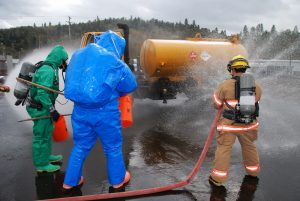On June 18, the U.S. Chemical Safety and Hazard Investigation Board (CSB) released a second update regarding its continuing investigation into the November 12, 2024, explosion at the Givaudan Sense Colour facility in Louisville, Kentucky.
Two employees were fatally injured in the explosion, and three others were seriously injured. Large metal fragments of equipment were thrown up to 400 feet away from the facility, damaging nearby homes and businesses and prompting local officials to issue a shelter-in-place order for a one-mile radius.
The facility has since ceased operations and is being demolished.
At the time of the incident, the facility was producing caramel food coloring in a batch reactor. CSB investigators conducted laboratory reactivity tests on representative samples to determine whether the material being processed in the reactor experienced a hazardous “runaway” reaction on the day of the incident.
The CSB’s tests confirmed that the materials in the reactor could cause a hazardous runaway reaction and an explosion like the one that occurred at Givaudan Sense Colour.
Chemicals used on the day of the incident included sugar, phosphoric acid, sodium hydroxide, water, and an antifoam additive. The CSB used analytical tests, including automatic pressure tracking adiabatic calorimetry (APTAC) and accelerating rate calorimetry (ARC), to determine the chemicals’ stability when heated inside an enclosed vessel. Both APTAC and ARC are laboratory testing methods whereby materials in a reaction vessel are incrementally heated until the heat released from the chemical reaction is detected.
Additional reactivity tests were conducted on both the batch reactor mixture and the sugar ingredient alone to determine how much each might have contributed to a runaway reaction in the batch reactor.
The tests showed rapid and dangerously high increases in both pressure and temperature far beyond the reactor’s safe limits as the materials were processed. Pressures exceeded 1,500 pounds per square inch gauge (psig), and temperatures rose over 280° F during testing. Gases, consisting primarily of carbon dioxide, were produced during these reactions, contributing to increased pressure.
The CSB noted it had investigated multiple incidents in which runaway reactions inside equipment have caused explosions and significant damage. The Givaudan incident exhibited similarities to prior incidents the board has investigated, including the use of a batch production process, a rapid and uncontrolled rise in pressure and temperature, and an explosion that caused significant damage.
The CSB continues to examine the causes of the explosion, including equipment analysis and evaluation of the reactor’s relief system. Once the board completes its investigation, it will issue a final report with findings and safety recommendations.
An independent federal government board, the CSB investigates industrial chemical incidents and makes safety recommendations to companies, industry organizations, labor unions, and regulatory agencies, including the Environmental Protection Agency (EPA) and Occupational Safety and Health Administration (OSHA). However, it doesn’t issue citations for regulatory violations or impose any fines. Board members are appointed by the president and are subject to Senate confirmation.

